BMF's E-Commerce Migration Plan: IT-Driven Business Reengineering
VerifiedAdded on 2023/06/12
|12
|3291
|386
Report
AI Summary
This report outlines an e-commerce migration plan for BMF, a computer services and products company, aiming to enhance its competitiveness through IT-based Business Process Reengineering (BPR). The current state of BMF, characterized by legacy systems and limited e-business capabilities, necessitates a shift to a modern, e-business-based enterprise system. The proposed migration plan involves a stepwise approach, digitizing existing systems, implementing new enterprise and communication systems in a hybrid cloud environment, and developing a data-driven e-commerce website. This transition will significantly impact BMF's infrastructure, culture, and operational processes, leading to improved customer interaction, data-driven decision making, and streamlined operations. The report also identifies and discusses measurable benefits such as increased revenue, new customer acquisition, cost reduction, and enhanced productivity, as well as potential risks associated with the migration project, emphasizing the need for effective risk management.

E-COMMERCE MIGRATION PLAN
NAME
DATE
NAME
DATE
Paraphrase This Document
Need a fresh take? Get an instant paraphrase of this document with our AI Paraphraser
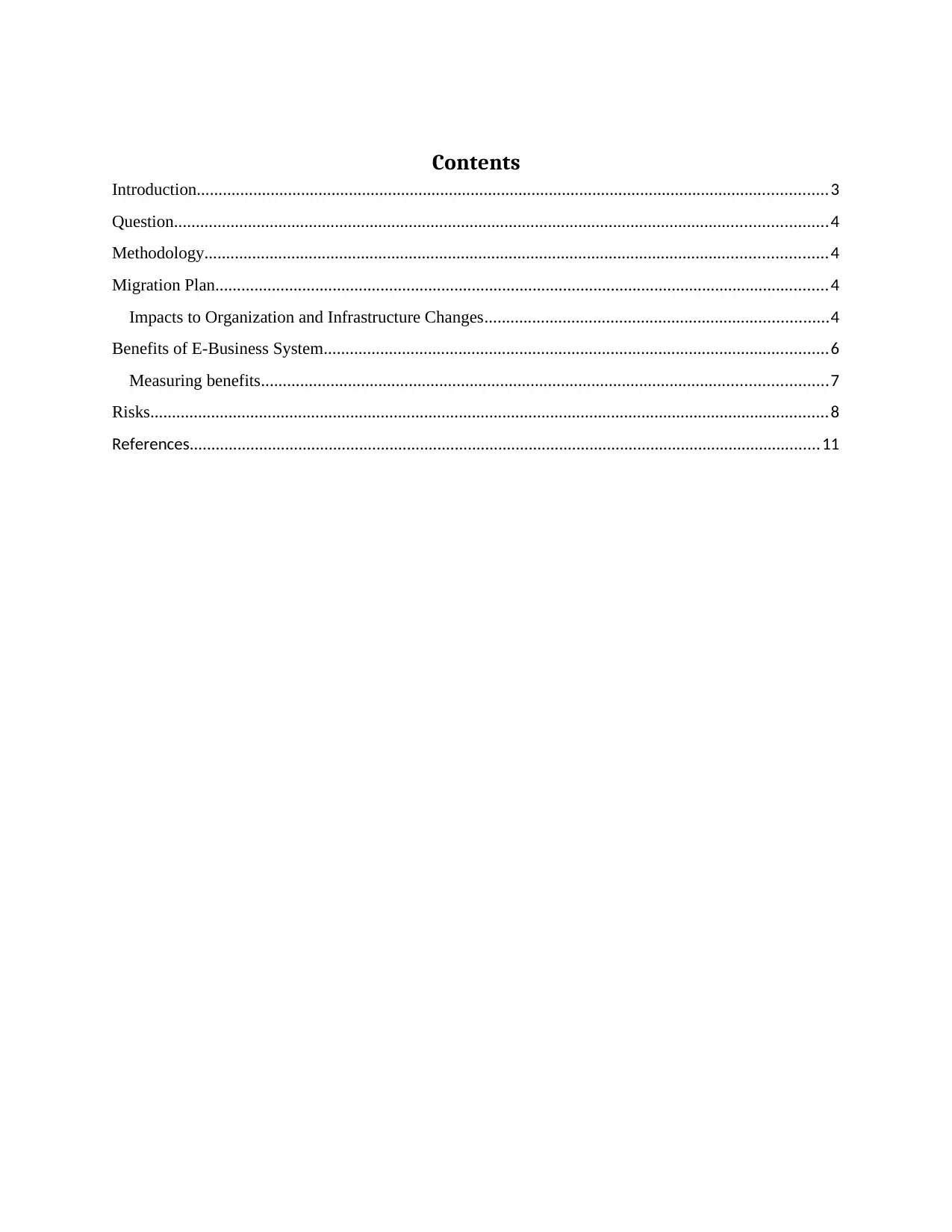
Contents
Introduction.................................................................................................................................................3
Question......................................................................................................................................................4
Methodology...............................................................................................................................................4
Migration Plan.............................................................................................................................................4
Impacts to Organization and Infrastructure Changes...............................................................................4
Benefits of E-Business System....................................................................................................................6
Measuring benefits..................................................................................................................................7
Risks............................................................................................................................................................8
References.................................................................................................................................................11
Introduction.................................................................................................................................................3
Question......................................................................................................................................................4
Methodology...............................................................................................................................................4
Migration Plan.............................................................................................................................................4
Impacts to Organization and Infrastructure Changes...............................................................................4
Benefits of E-Business System....................................................................................................................6
Measuring benefits..................................................................................................................................7
Risks............................................................................................................................................................8
References.................................................................................................................................................11
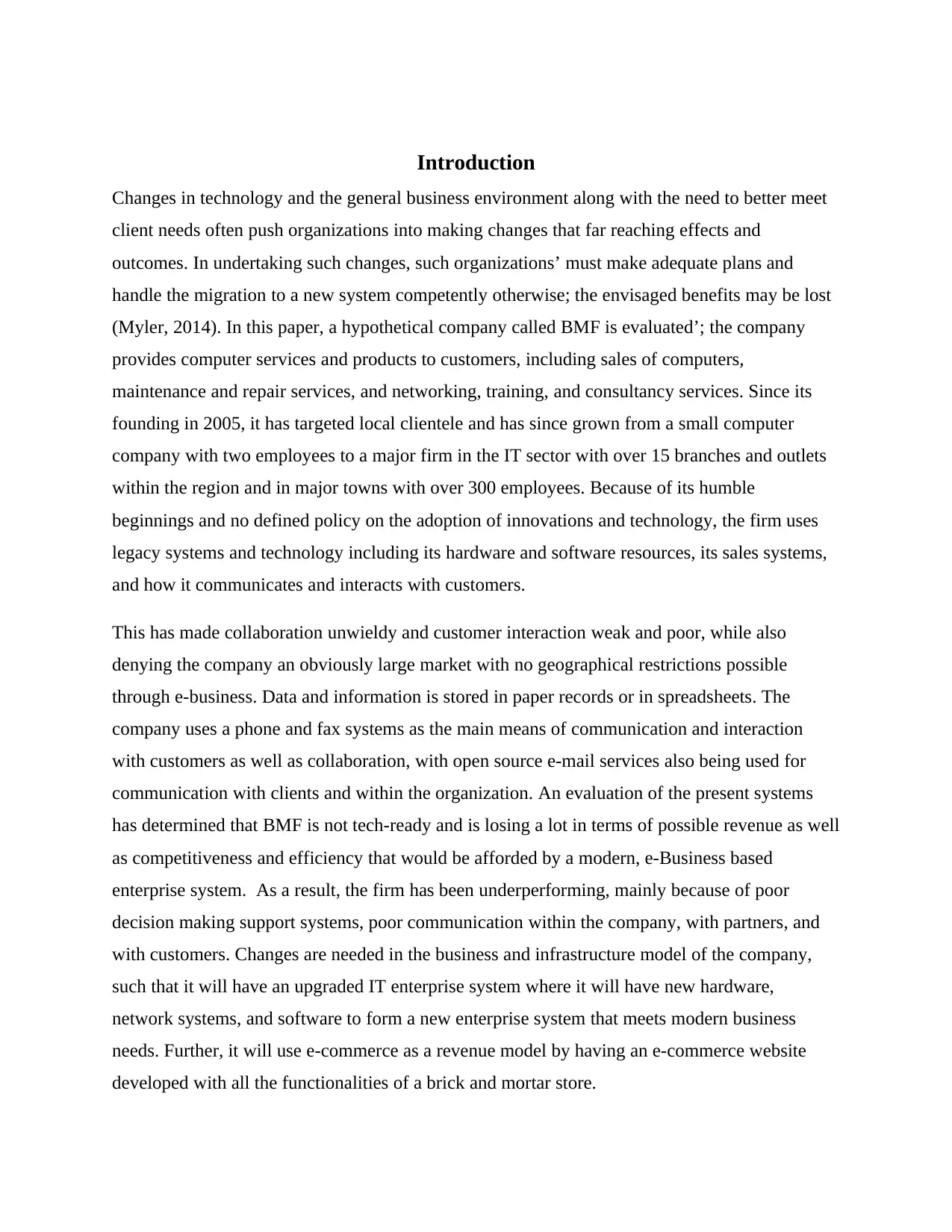
Introduction
Changes in technology and the general business environment along with the need to better meet
client needs often push organizations into making changes that far reaching effects and
outcomes. In undertaking such changes, such organizations’ must make adequate plans and
handle the migration to a new system competently otherwise; the envisaged benefits may be lost
(Myler, 2014). In this paper, a hypothetical company called BMF is evaluated’; the company
provides computer services and products to customers, including sales of computers,
maintenance and repair services, and networking, training, and consultancy services. Since its
founding in 2005, it has targeted local clientele and has since grown from a small computer
company with two employees to a major firm in the IT sector with over 15 branches and outlets
within the region and in major towns with over 300 employees. Because of its humble
beginnings and no defined policy on the adoption of innovations and technology, the firm uses
legacy systems and technology including its hardware and software resources, its sales systems,
and how it communicates and interacts with customers.
This has made collaboration unwieldy and customer interaction weak and poor, while also
denying the company an obviously large market with no geographical restrictions possible
through e-business. Data and information is stored in paper records or in spreadsheets. The
company uses a phone and fax systems as the main means of communication and interaction
with customers as well as collaboration, with open source e-mail services also being used for
communication with clients and within the organization. An evaluation of the present systems
has determined that BMF is not tech-ready and is losing a lot in terms of possible revenue as well
as competitiveness and efficiency that would be afforded by a modern, e-Business based
enterprise system. As a result, the firm has been underperforming, mainly because of poor
decision making support systems, poor communication within the company, with partners, and
with customers. Changes are needed in the business and infrastructure model of the company,
such that it will have an upgraded IT enterprise system where it will have new hardware,
network systems, and software to form a new enterprise system that meets modern business
needs. Further, it will use e-commerce as a revenue model by having an e-commerce website
developed with all the functionalities of a brick and mortar store.
Changes in technology and the general business environment along with the need to better meet
client needs often push organizations into making changes that far reaching effects and
outcomes. In undertaking such changes, such organizations’ must make adequate plans and
handle the migration to a new system competently otherwise; the envisaged benefits may be lost
(Myler, 2014). In this paper, a hypothetical company called BMF is evaluated’; the company
provides computer services and products to customers, including sales of computers,
maintenance and repair services, and networking, training, and consultancy services. Since its
founding in 2005, it has targeted local clientele and has since grown from a small computer
company with two employees to a major firm in the IT sector with over 15 branches and outlets
within the region and in major towns with over 300 employees. Because of its humble
beginnings and no defined policy on the adoption of innovations and technology, the firm uses
legacy systems and technology including its hardware and software resources, its sales systems,
and how it communicates and interacts with customers.
This has made collaboration unwieldy and customer interaction weak and poor, while also
denying the company an obviously large market with no geographical restrictions possible
through e-business. Data and information is stored in paper records or in spreadsheets. The
company uses a phone and fax systems as the main means of communication and interaction
with customers as well as collaboration, with open source e-mail services also being used for
communication with clients and within the organization. An evaluation of the present systems
has determined that BMF is not tech-ready and is losing a lot in terms of possible revenue as well
as competitiveness and efficiency that would be afforded by a modern, e-Business based
enterprise system. As a result, the firm has been underperforming, mainly because of poor
decision making support systems, poor communication within the company, with partners, and
with customers. Changes are needed in the business and infrastructure model of the company,
such that it will have an upgraded IT enterprise system where it will have new hardware,
network systems, and software to form a new enterprise system that meets modern business
needs. Further, it will use e-commerce as a revenue model by having an e-commerce website
developed with all the functionalities of a brick and mortar store.
⊘ This is a preview!⊘
Do you want full access?
Subscribe today to unlock all pages.

Trusted by 1+ million students worldwide
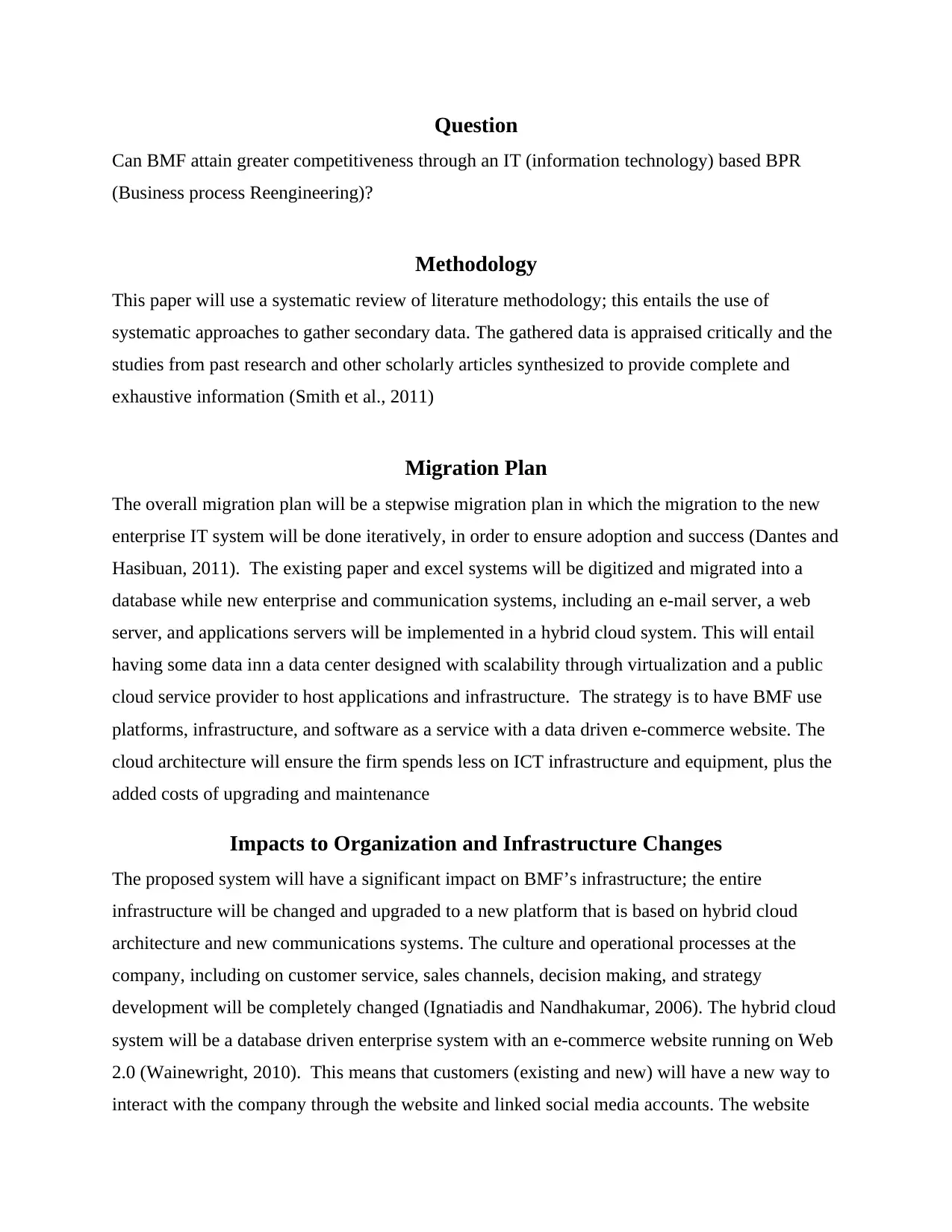
Question
Can BMF attain greater competitiveness through an IT (information technology) based BPR
(Business process Reengineering)?
Methodology
This paper will use a systematic review of literature methodology; this entails the use of
systematic approaches to gather secondary data. The gathered data is appraised critically and the
studies from past research and other scholarly articles synthesized to provide complete and
exhaustive information (Smith et al., 2011)
Migration Plan
The overall migration plan will be a stepwise migration plan in which the migration to the new
enterprise IT system will be done iteratively, in order to ensure adoption and success (Dantes and
Hasibuan, 2011). The existing paper and excel systems will be digitized and migrated into a
database while new enterprise and communication systems, including an e-mail server, a web
server, and applications servers will be implemented in a hybrid cloud system. This will entail
having some data inn a data center designed with scalability through virtualization and a public
cloud service provider to host applications and infrastructure. The strategy is to have BMF use
platforms, infrastructure, and software as a service with a data driven e-commerce website. The
cloud architecture will ensure the firm spends less on ICT infrastructure and equipment, plus the
added costs of upgrading and maintenance
Impacts to Organization and Infrastructure Changes
The proposed system will have a significant impact on BMF’s infrastructure; the entire
infrastructure will be changed and upgraded to a new platform that is based on hybrid cloud
architecture and new communications systems. The culture and operational processes at the
company, including on customer service, sales channels, decision making, and strategy
development will be completely changed (Ignatiadis and Nandhakumar, 2006). The hybrid cloud
system will be a database driven enterprise system with an e-commerce website running on Web
2.0 (Wainewright, 2010). This means that customers (existing and new) will have a new way to
interact with the company through the website and linked social media accounts. The website
Can BMF attain greater competitiveness through an IT (information technology) based BPR
(Business process Reengineering)?
Methodology
This paper will use a systematic review of literature methodology; this entails the use of
systematic approaches to gather secondary data. The gathered data is appraised critically and the
studies from past research and other scholarly articles synthesized to provide complete and
exhaustive information (Smith et al., 2011)
Migration Plan
The overall migration plan will be a stepwise migration plan in which the migration to the new
enterprise IT system will be done iteratively, in order to ensure adoption and success (Dantes and
Hasibuan, 2011). The existing paper and excel systems will be digitized and migrated into a
database while new enterprise and communication systems, including an e-mail server, a web
server, and applications servers will be implemented in a hybrid cloud system. This will entail
having some data inn a data center designed with scalability through virtualization and a public
cloud service provider to host applications and infrastructure. The strategy is to have BMF use
platforms, infrastructure, and software as a service with a data driven e-commerce website. The
cloud architecture will ensure the firm spends less on ICT infrastructure and equipment, plus the
added costs of upgrading and maintenance
Impacts to Organization and Infrastructure Changes
The proposed system will have a significant impact on BMF’s infrastructure; the entire
infrastructure will be changed and upgraded to a new platform that is based on hybrid cloud
architecture and new communications systems. The culture and operational processes at the
company, including on customer service, sales channels, decision making, and strategy
development will be completely changed (Ignatiadis and Nandhakumar, 2006). The hybrid cloud
system will be a database driven enterprise system with an e-commerce website running on Web
2.0 (Wainewright, 2010). This means that customers (existing and new) will have a new way to
interact with the company through the website and linked social media accounts. The website
Paraphrase This Document
Need a fresh take? Get an instant paraphrase of this document with our AI Paraphraser
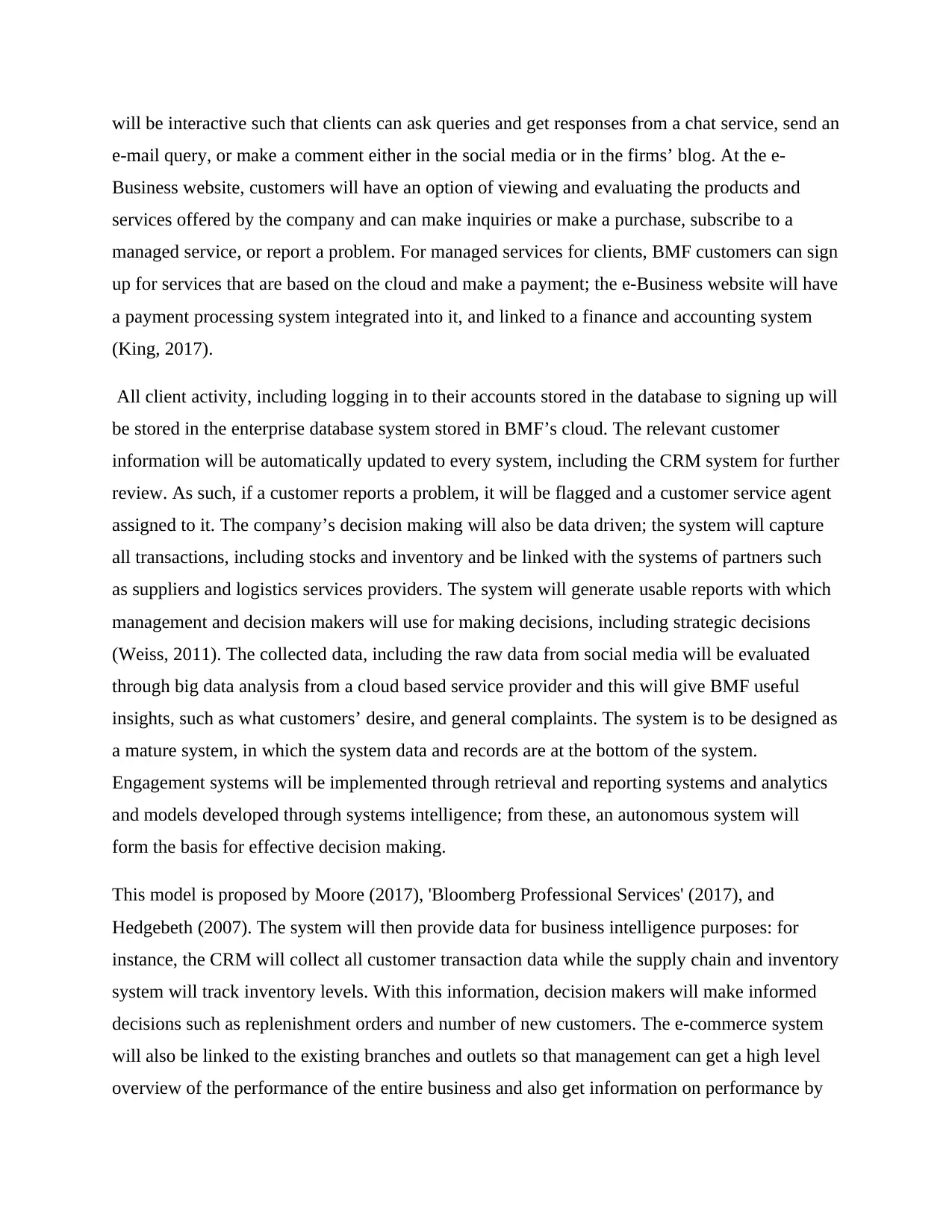
will be interactive such that clients can ask queries and get responses from a chat service, send an
e-mail query, or make a comment either in the social media or in the firms’ blog. At the e-
Business website, customers will have an option of viewing and evaluating the products and
services offered by the company and can make inquiries or make a purchase, subscribe to a
managed service, or report a problem. For managed services for clients, BMF customers can sign
up for services that are based on the cloud and make a payment; the e-Business website will have
a payment processing system integrated into it, and linked to a finance and accounting system
(King, 2017).
All client activity, including logging in to their accounts stored in the database to signing up will
be stored in the enterprise database system stored in BMF’s cloud. The relevant customer
information will be automatically updated to every system, including the CRM system for further
review. As such, if a customer reports a problem, it will be flagged and a customer service agent
assigned to it. The company’s decision making will also be data driven; the system will capture
all transactions, including stocks and inventory and be linked with the systems of partners such
as suppliers and logistics services providers. The system will generate usable reports with which
management and decision makers will use for making decisions, including strategic decisions
(Weiss, 2011). The collected data, including the raw data from social media will be evaluated
through big data analysis from a cloud based service provider and this will give BMF useful
insights, such as what customers’ desire, and general complaints. The system is to be designed as
a mature system, in which the system data and records are at the bottom of the system.
Engagement systems will be implemented through retrieval and reporting systems and analytics
and models developed through systems intelligence; from these, an autonomous system will
form the basis for effective decision making.
This model is proposed by Moore (2017), 'Bloomberg Professional Services' (2017), and
Hedgebeth (2007). The system will then provide data for business intelligence purposes: for
instance, the CRM will collect all customer transaction data while the supply chain and inventory
system will track inventory levels. With this information, decision makers will make informed
decisions such as replenishment orders and number of new customers. The e-commerce system
will also be linked to the existing branches and outlets so that management can get a high level
overview of the performance of the entire business and also get information on performance by
e-mail query, or make a comment either in the social media or in the firms’ blog. At the e-
Business website, customers will have an option of viewing and evaluating the products and
services offered by the company and can make inquiries or make a purchase, subscribe to a
managed service, or report a problem. For managed services for clients, BMF customers can sign
up for services that are based on the cloud and make a payment; the e-Business website will have
a payment processing system integrated into it, and linked to a finance and accounting system
(King, 2017).
All client activity, including logging in to their accounts stored in the database to signing up will
be stored in the enterprise database system stored in BMF’s cloud. The relevant customer
information will be automatically updated to every system, including the CRM system for further
review. As such, if a customer reports a problem, it will be flagged and a customer service agent
assigned to it. The company’s decision making will also be data driven; the system will capture
all transactions, including stocks and inventory and be linked with the systems of partners such
as suppliers and logistics services providers. The system will generate usable reports with which
management and decision makers will use for making decisions, including strategic decisions
(Weiss, 2011). The collected data, including the raw data from social media will be evaluated
through big data analysis from a cloud based service provider and this will give BMF useful
insights, such as what customers’ desire, and general complaints. The system is to be designed as
a mature system, in which the system data and records are at the bottom of the system.
Engagement systems will be implemented through retrieval and reporting systems and analytics
and models developed through systems intelligence; from these, an autonomous system will
form the basis for effective decision making.
This model is proposed by Moore (2017), 'Bloomberg Professional Services' (2017), and
Hedgebeth (2007). The system will then provide data for business intelligence purposes: for
instance, the CRM will collect all customer transaction data while the supply chain and inventory
system will track inventory levels. With this information, decision makers will make informed
decisions such as replenishment orders and number of new customers. The e-commerce system
will also be linked to the existing branches and outlets so that management can get a high level
overview of the performance of the entire business and also get information on performance by
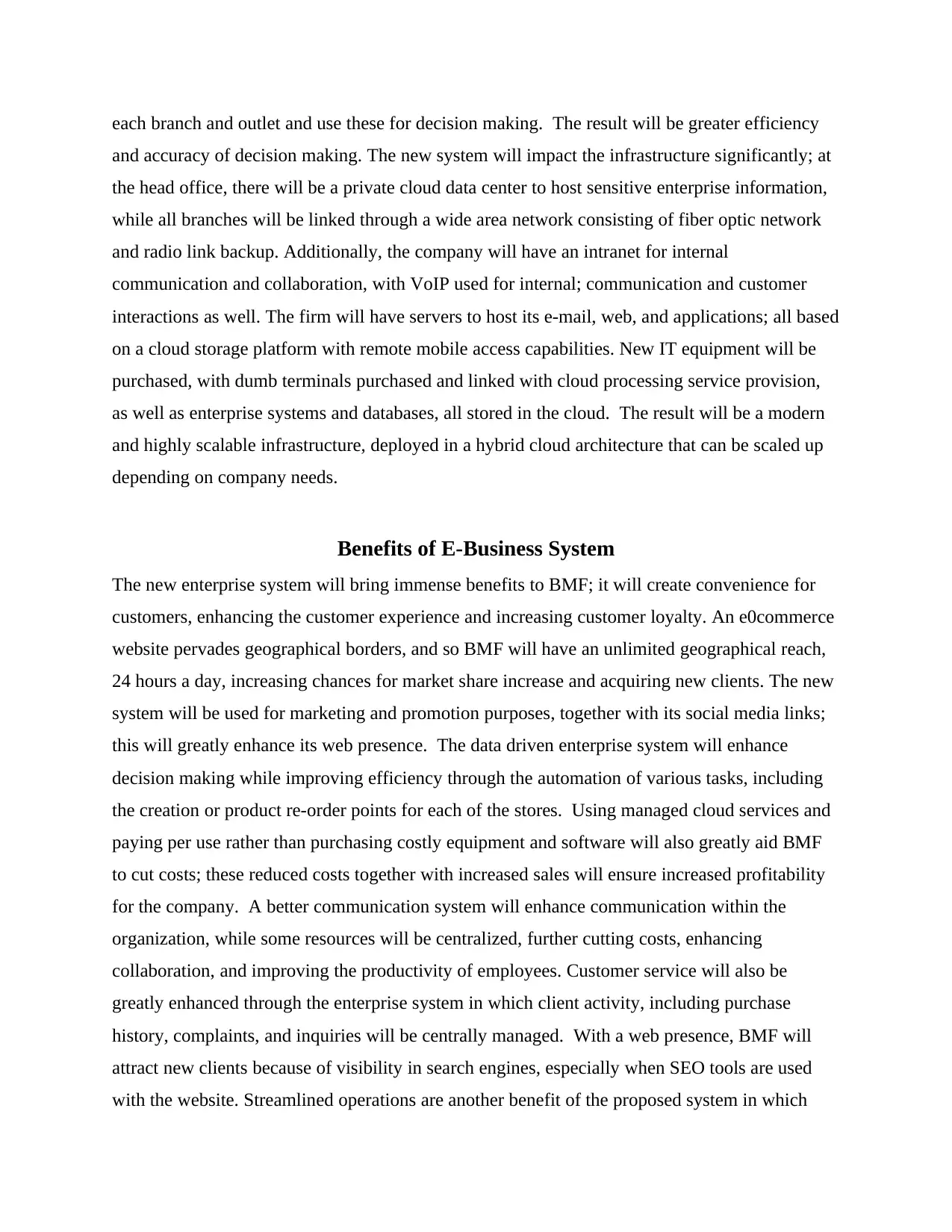
each branch and outlet and use these for decision making. The result will be greater efficiency
and accuracy of decision making. The new system will impact the infrastructure significantly; at
the head office, there will be a private cloud data center to host sensitive enterprise information,
while all branches will be linked through a wide area network consisting of fiber optic network
and radio link backup. Additionally, the company will have an intranet for internal
communication and collaboration, with VoIP used for internal; communication and customer
interactions as well. The firm will have servers to host its e-mail, web, and applications; all based
on a cloud storage platform with remote mobile access capabilities. New IT equipment will be
purchased, with dumb terminals purchased and linked with cloud processing service provision,
as well as enterprise systems and databases, all stored in the cloud. The result will be a modern
and highly scalable infrastructure, deployed in a hybrid cloud architecture that can be scaled up
depending on company needs.
Benefits of E-Business System
The new enterprise system will bring immense benefits to BMF; it will create convenience for
customers, enhancing the customer experience and increasing customer loyalty. An e0commerce
website pervades geographical borders, and so BMF will have an unlimited geographical reach,
24 hours a day, increasing chances for market share increase and acquiring new clients. The new
system will be used for marketing and promotion purposes, together with its social media links;
this will greatly enhance its web presence. The data driven enterprise system will enhance
decision making while improving efficiency through the automation of various tasks, including
the creation or product re-order points for each of the stores. Using managed cloud services and
paying per use rather than purchasing costly equipment and software will also greatly aid BMF
to cut costs; these reduced costs together with increased sales will ensure increased profitability
for the company. A better communication system will enhance communication within the
organization, while some resources will be centralized, further cutting costs, enhancing
collaboration, and improving the productivity of employees. Customer service will also be
greatly enhanced through the enterprise system in which client activity, including purchase
history, complaints, and inquiries will be centrally managed. With a web presence, BMF will
attract new clients because of visibility in search engines, especially when SEO tools are used
with the website. Streamlined operations are another benefit of the proposed system in which
and accuracy of decision making. The new system will impact the infrastructure significantly; at
the head office, there will be a private cloud data center to host sensitive enterprise information,
while all branches will be linked through a wide area network consisting of fiber optic network
and radio link backup. Additionally, the company will have an intranet for internal
communication and collaboration, with VoIP used for internal; communication and customer
interactions as well. The firm will have servers to host its e-mail, web, and applications; all based
on a cloud storage platform with remote mobile access capabilities. New IT equipment will be
purchased, with dumb terminals purchased and linked with cloud processing service provision,
as well as enterprise systems and databases, all stored in the cloud. The result will be a modern
and highly scalable infrastructure, deployed in a hybrid cloud architecture that can be scaled up
depending on company needs.
Benefits of E-Business System
The new enterprise system will bring immense benefits to BMF; it will create convenience for
customers, enhancing the customer experience and increasing customer loyalty. An e0commerce
website pervades geographical borders, and so BMF will have an unlimited geographical reach,
24 hours a day, increasing chances for market share increase and acquiring new clients. The new
system will be used for marketing and promotion purposes, together with its social media links;
this will greatly enhance its web presence. The data driven enterprise system will enhance
decision making while improving efficiency through the automation of various tasks, including
the creation or product re-order points for each of the stores. Using managed cloud services and
paying per use rather than purchasing costly equipment and software will also greatly aid BMF
to cut costs; these reduced costs together with increased sales will ensure increased profitability
for the company. A better communication system will enhance communication within the
organization, while some resources will be centralized, further cutting costs, enhancing
collaboration, and improving the productivity of employees. Customer service will also be
greatly enhanced through the enterprise system in which client activity, including purchase
history, complaints, and inquiries will be centrally managed. With a web presence, BMF will
attract new clients because of visibility in search engines, especially when SEO tools are used
with the website. Streamlined operations are another benefit of the proposed system in which
⊘ This is a preview!⊘
Do you want full access?
Subscribe today to unlock all pages.

Trusted by 1+ million students worldwide
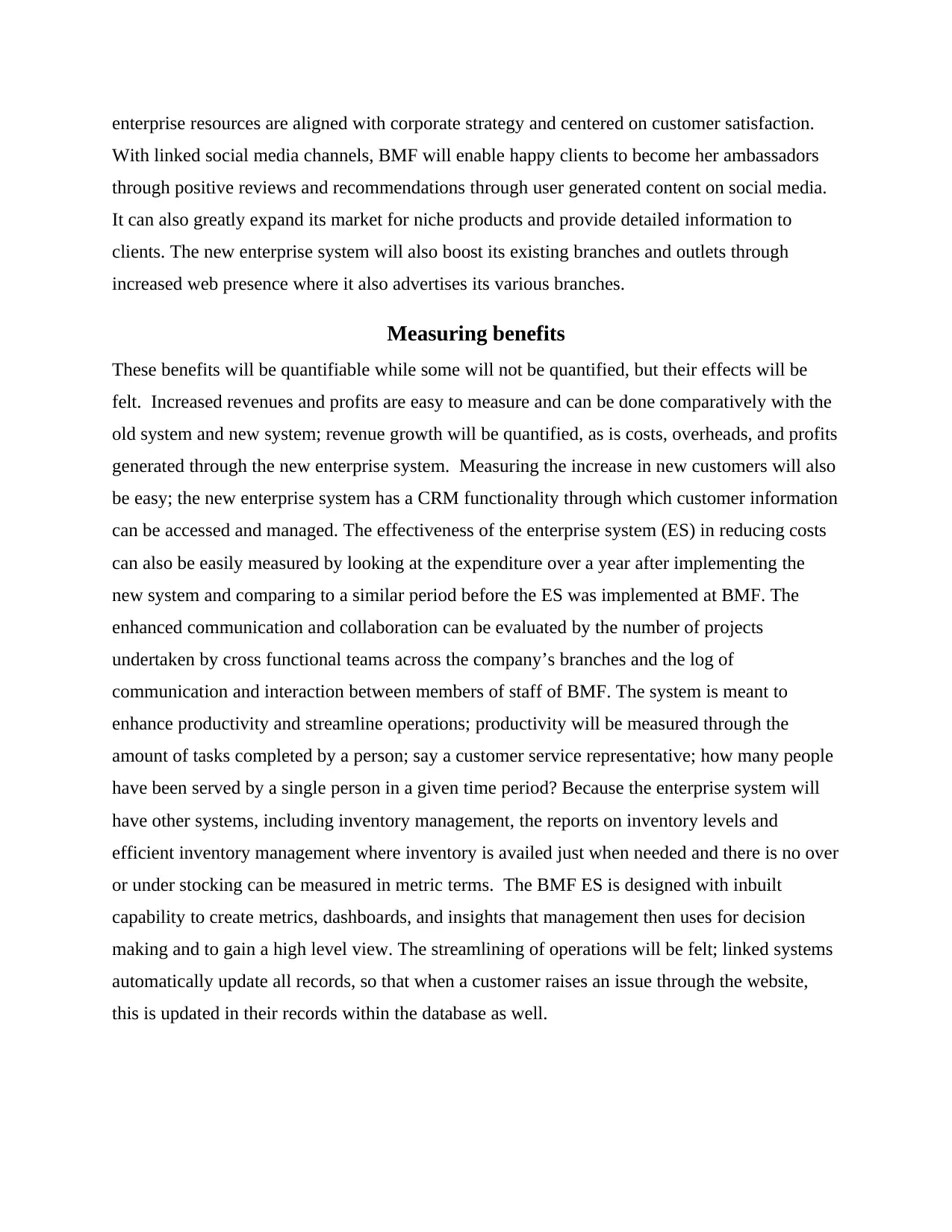
enterprise resources are aligned with corporate strategy and centered on customer satisfaction.
With linked social media channels, BMF will enable happy clients to become her ambassadors
through positive reviews and recommendations through user generated content on social media.
It can also greatly expand its market for niche products and provide detailed information to
clients. The new enterprise system will also boost its existing branches and outlets through
increased web presence where it also advertises its various branches.
Measuring benefits
These benefits will be quantifiable while some will not be quantified, but their effects will be
felt. Increased revenues and profits are easy to measure and can be done comparatively with the
old system and new system; revenue growth will be quantified, as is costs, overheads, and profits
generated through the new enterprise system. Measuring the increase in new customers will also
be easy; the new enterprise system has a CRM functionality through which customer information
can be accessed and managed. The effectiveness of the enterprise system (ES) in reducing costs
can also be easily measured by looking at the expenditure over a year after implementing the
new system and comparing to a similar period before the ES was implemented at BMF. The
enhanced communication and collaboration can be evaluated by the number of projects
undertaken by cross functional teams across the company’s branches and the log of
communication and interaction between members of staff of BMF. The system is meant to
enhance productivity and streamline operations; productivity will be measured through the
amount of tasks completed by a person; say a customer service representative; how many people
have been served by a single person in a given time period? Because the enterprise system will
have other systems, including inventory management, the reports on inventory levels and
efficient inventory management where inventory is availed just when needed and there is no over
or under stocking can be measured in metric terms. The BMF ES is designed with inbuilt
capability to create metrics, dashboards, and insights that management then uses for decision
making and to gain a high level view. The streamlining of operations will be felt; linked systems
automatically update all records, so that when a customer raises an issue through the website,
this is updated in their records within the database as well.
With linked social media channels, BMF will enable happy clients to become her ambassadors
through positive reviews and recommendations through user generated content on social media.
It can also greatly expand its market for niche products and provide detailed information to
clients. The new enterprise system will also boost its existing branches and outlets through
increased web presence where it also advertises its various branches.
Measuring benefits
These benefits will be quantifiable while some will not be quantified, but their effects will be
felt. Increased revenues and profits are easy to measure and can be done comparatively with the
old system and new system; revenue growth will be quantified, as is costs, overheads, and profits
generated through the new enterprise system. Measuring the increase in new customers will also
be easy; the new enterprise system has a CRM functionality through which customer information
can be accessed and managed. The effectiveness of the enterprise system (ES) in reducing costs
can also be easily measured by looking at the expenditure over a year after implementing the
new system and comparing to a similar period before the ES was implemented at BMF. The
enhanced communication and collaboration can be evaluated by the number of projects
undertaken by cross functional teams across the company’s branches and the log of
communication and interaction between members of staff of BMF. The system is meant to
enhance productivity and streamline operations; productivity will be measured through the
amount of tasks completed by a person; say a customer service representative; how many people
have been served by a single person in a given time period? Because the enterprise system will
have other systems, including inventory management, the reports on inventory levels and
efficient inventory management where inventory is availed just when needed and there is no over
or under stocking can be measured in metric terms. The BMF ES is designed with inbuilt
capability to create metrics, dashboards, and insights that management then uses for decision
making and to gain a high level view. The streamlining of operations will be felt; linked systems
automatically update all records, so that when a customer raises an issue through the website,
this is updated in their records within the database as well.
Paraphrase This Document
Need a fresh take? Get an instant paraphrase of this document with our AI Paraphraser
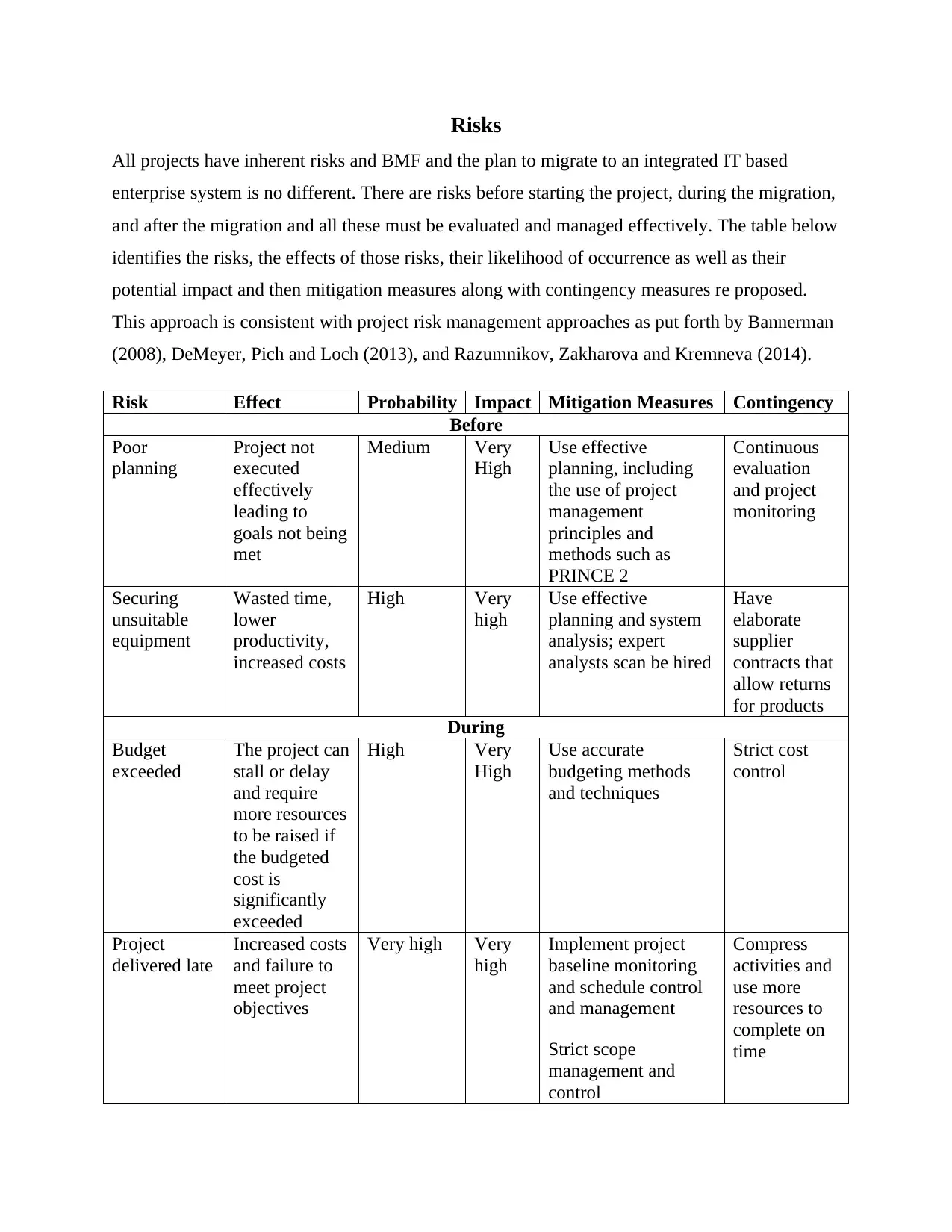
Risks
All projects have inherent risks and BMF and the plan to migrate to an integrated IT based
enterprise system is no different. There are risks before starting the project, during the migration,
and after the migration and all these must be evaluated and managed effectively. The table below
identifies the risks, the effects of those risks, their likelihood of occurrence as well as their
potential impact and then mitigation measures along with contingency measures re proposed.
This approach is consistent with project risk management approaches as put forth by Bannerman
(2008), DeMeyer, Pich and Loch (2013), and Razumnikov, Zakharova and Kremneva (2014).
Risk Effect Probability Impact Mitigation Measures Contingency
Before
Poor
planning
Project not
executed
effectively
leading to
goals not being
met
Medium Very
High
Use effective
planning, including
the use of project
management
principles and
methods such as
PRINCE 2
Continuous
evaluation
and project
monitoring
Securing
unsuitable
equipment
Wasted time,
lower
productivity,
increased costs
High Very
high
Use effective
planning and system
analysis; expert
analysts scan be hired
Have
elaborate
supplier
contracts that
allow returns
for products
During
Budget
exceeded
The project can
stall or delay
and require
more resources
to be raised if
the budgeted
cost is
significantly
exceeded
High Very
High
Use accurate
budgeting methods
and techniques
Strict cost
control
Project
delivered late
Increased costs
and failure to
meet project
objectives
Very high Very
high
Implement project
baseline monitoring
and schedule control
and management
Strict scope
management and
control
Compress
activities and
use more
resources to
complete on
time
All projects have inherent risks and BMF and the plan to migrate to an integrated IT based
enterprise system is no different. There are risks before starting the project, during the migration,
and after the migration and all these must be evaluated and managed effectively. The table below
identifies the risks, the effects of those risks, their likelihood of occurrence as well as their
potential impact and then mitigation measures along with contingency measures re proposed.
This approach is consistent with project risk management approaches as put forth by Bannerman
(2008), DeMeyer, Pich and Loch (2013), and Razumnikov, Zakharova and Kremneva (2014).
Risk Effect Probability Impact Mitigation Measures Contingency
Before
Poor
planning
Project not
executed
effectively
leading to
goals not being
met
Medium Very
High
Use effective
planning, including
the use of project
management
principles and
methods such as
PRINCE 2
Continuous
evaluation
and project
monitoring
Securing
unsuitable
equipment
Wasted time,
lower
productivity,
increased costs
High Very
high
Use effective
planning and system
analysis; expert
analysts scan be hired
Have
elaborate
supplier
contracts that
allow returns
for products
During
Budget
exceeded
The project can
stall or delay
and require
more resources
to be raised if
the budgeted
cost is
significantly
exceeded
High Very
High
Use accurate
budgeting methods
and techniques
Strict cost
control
Project
delivered late
Increased costs
and failure to
meet project
objectives
Very high Very
high
Implement project
baseline monitoring
and schedule control
and management
Strict scope
management and
control
Compress
activities and
use more
resources to
complete on
time
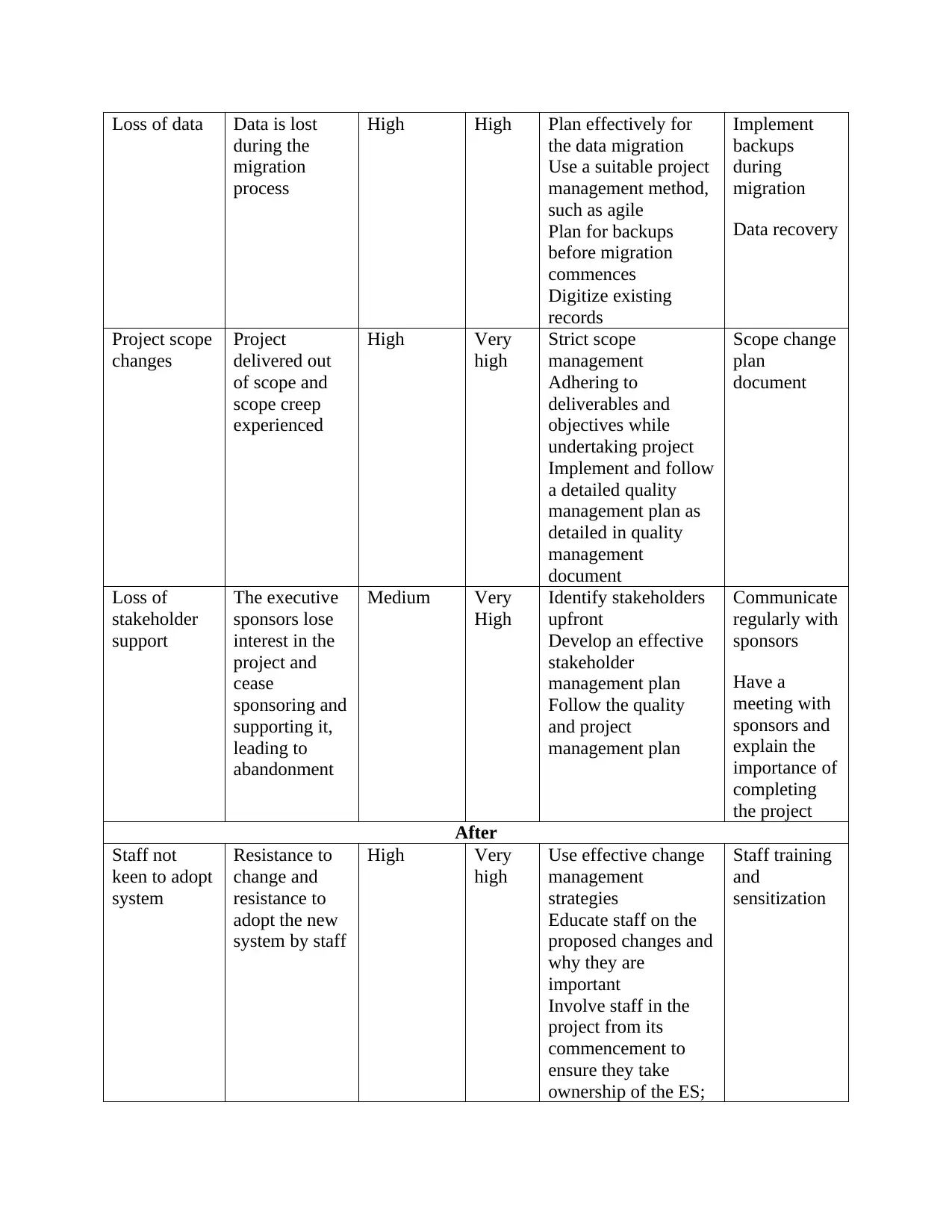
Loss of data Data is lost
during the
migration
process
High High Plan effectively for
the data migration
Use a suitable project
management method,
such as agile
Plan for backups
before migration
commences
Digitize existing
records
Implement
backups
during
migration
Data recovery
Project scope
changes
Project
delivered out
of scope and
scope creep
experienced
High Very
high
Strict scope
management
Adhering to
deliverables and
objectives while
undertaking project
Implement and follow
a detailed quality
management plan as
detailed in quality
management
document
Scope change
plan
document
Loss of
stakeholder
support
The executive
sponsors lose
interest in the
project and
cease
sponsoring and
supporting it,
leading to
abandonment
Medium Very
High
Identify stakeholders
upfront
Develop an effective
stakeholder
management plan
Follow the quality
and project
management plan
Communicate
regularly with
sponsors
Have a
meeting with
sponsors and
explain the
importance of
completing
the project
After
Staff not
keen to adopt
system
Resistance to
change and
resistance to
adopt the new
system by staff
High Very
high
Use effective change
management
strategies
Educate staff on the
proposed changes and
why they are
important
Involve staff in the
project from its
commencement to
ensure they take
ownership of the ES;
Staff training
and
sensitization
during the
migration
process
High High Plan effectively for
the data migration
Use a suitable project
management method,
such as agile
Plan for backups
before migration
commences
Digitize existing
records
Implement
backups
during
migration
Data recovery
Project scope
changes
Project
delivered out
of scope and
scope creep
experienced
High Very
high
Strict scope
management
Adhering to
deliverables and
objectives while
undertaking project
Implement and follow
a detailed quality
management plan as
detailed in quality
management
document
Scope change
plan
document
Loss of
stakeholder
support
The executive
sponsors lose
interest in the
project and
cease
sponsoring and
supporting it,
leading to
abandonment
Medium Very
High
Identify stakeholders
upfront
Develop an effective
stakeholder
management plan
Follow the quality
and project
management plan
Communicate
regularly with
sponsors
Have a
meeting with
sponsors and
explain the
importance of
completing
the project
After
Staff not
keen to adopt
system
Resistance to
change and
resistance to
adopt the new
system by staff
High Very
high
Use effective change
management
strategies
Educate staff on the
proposed changes and
why they are
important
Involve staff in the
project from its
commencement to
ensure they take
ownership of the ES;
Staff training
and
sensitization
⊘ This is a preview!⊘
Do you want full access?
Subscribe today to unlock all pages.

Trusted by 1+ million students worldwide
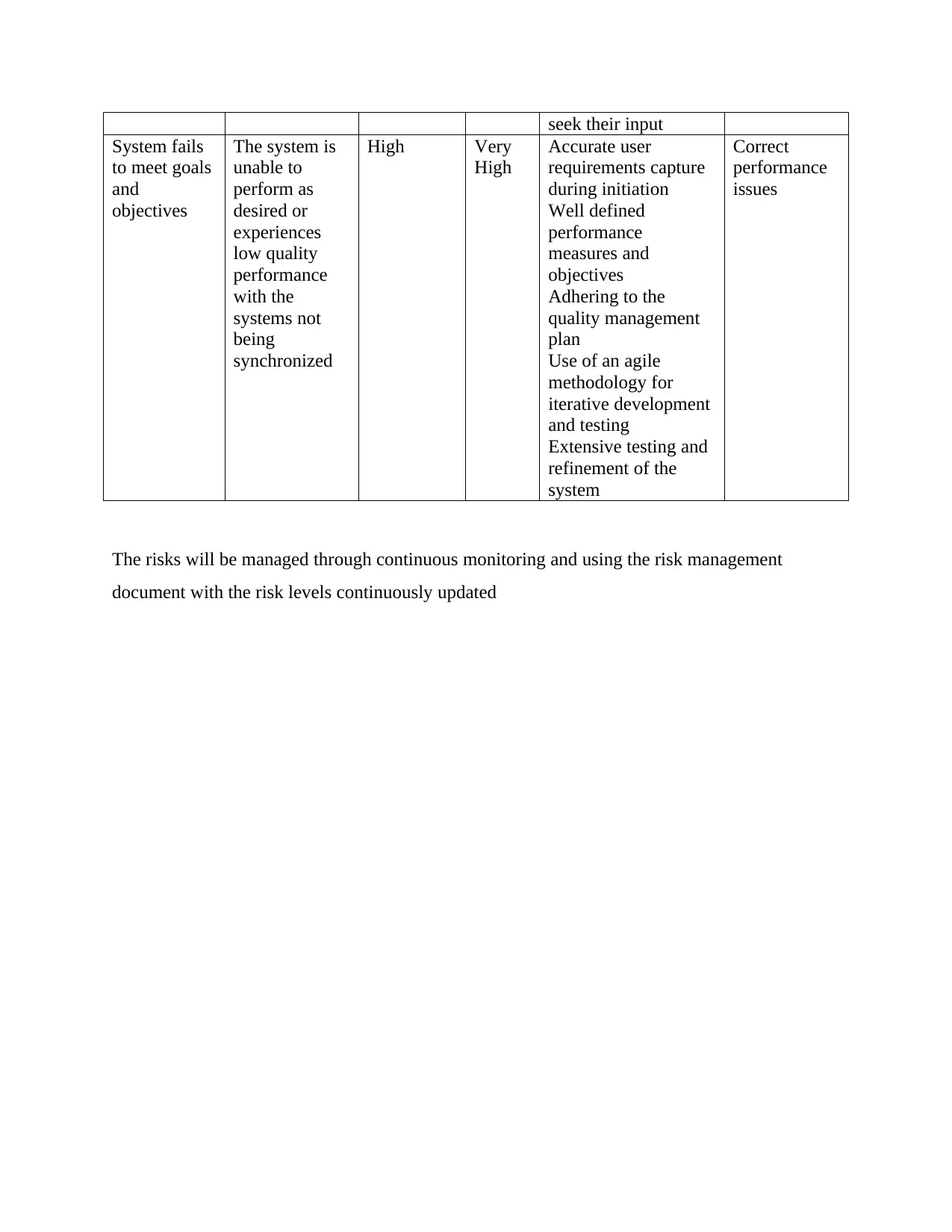
seek their input
System fails
to meet goals
and
objectives
The system is
unable to
perform as
desired or
experiences
low quality
performance
with the
systems not
being
synchronized
High Very
High
Accurate user
requirements capture
during initiation
Well defined
performance
measures and
objectives
Adhering to the
quality management
plan
Use of an agile
methodology for
iterative development
and testing
Extensive testing and
refinement of the
system
Correct
performance
issues
The risks will be managed through continuous monitoring and using the risk management
document with the risk levels continuously updated
System fails
to meet goals
and
objectives
The system is
unable to
perform as
desired or
experiences
low quality
performance
with the
systems not
being
synchronized
High Very
High
Accurate user
requirements capture
during initiation
Well defined
performance
measures and
objectives
Adhering to the
quality management
plan
Use of an agile
methodology for
iterative development
and testing
Extensive testing and
refinement of the
system
Correct
performance
issues
The risks will be managed through continuous monitoring and using the risk management
document with the risk levels continuously updated
Paraphrase This Document
Need a fresh take? Get an instant paraphrase of this document with our AI Paraphraser
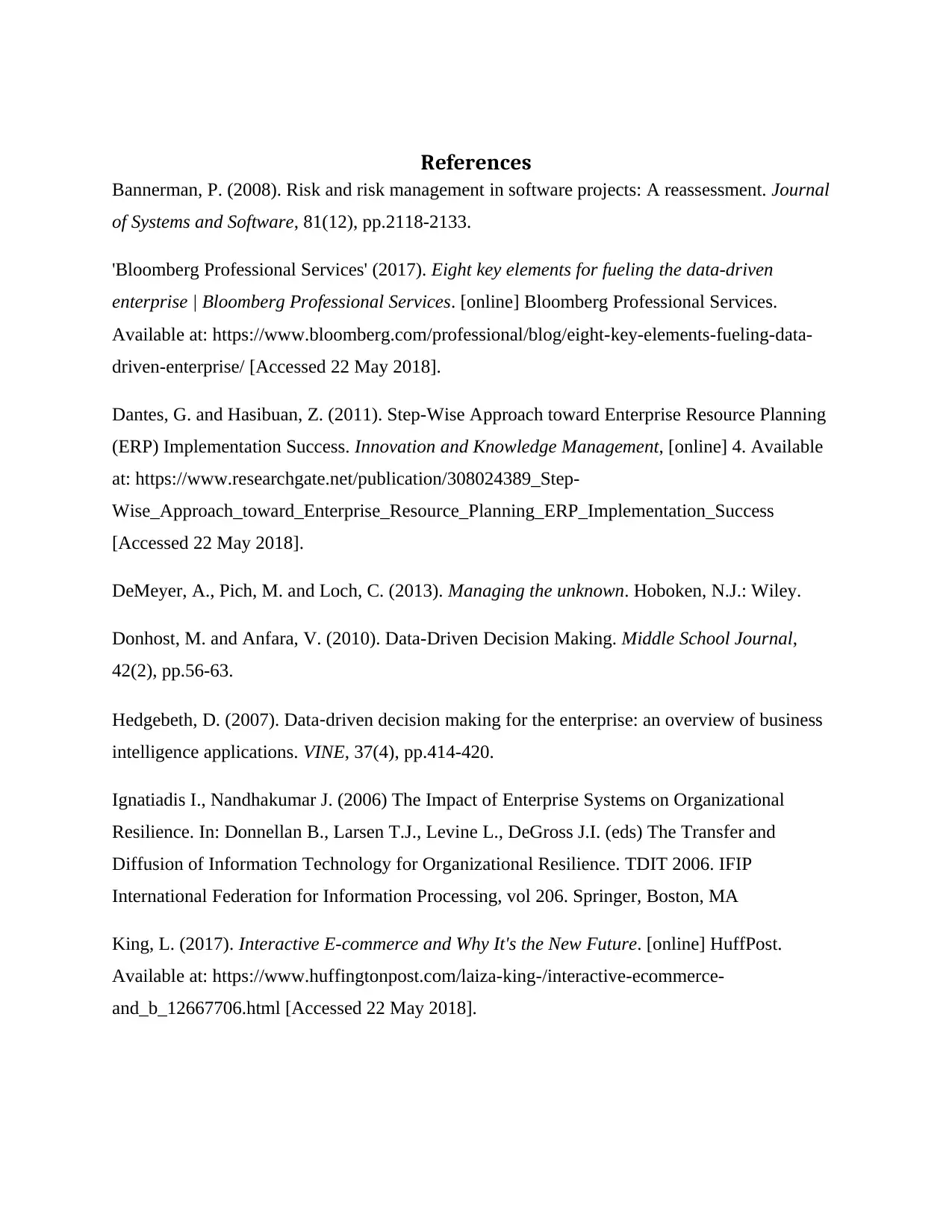
References
Bannerman, P. (2008). Risk and risk management in software projects: A reassessment. Journal
of Systems and Software, 81(12), pp.2118-2133.
'Bloomberg Professional Services' (2017). Eight key elements for fueling the data-driven
enterprise | Bloomberg Professional Services. [online] Bloomberg Professional Services.
Available at: https://www.bloomberg.com/professional/blog/eight-key-elements-fueling-data-
driven-enterprise/ [Accessed 22 May 2018].
Dantes, G. and Hasibuan, Z. (2011). Step-Wise Approach toward Enterprise Resource Planning
(ERP) Implementation Success. Innovation and Knowledge Management, [online] 4. Available
at: https://www.researchgate.net/publication/308024389_Step-
Wise_Approach_toward_Enterprise_Resource_Planning_ERP_Implementation_Success
[Accessed 22 May 2018].
DeMeyer, A., Pich, M. and Loch, C. (2013). Managing the unknown. Hoboken, N.J.: Wiley.
Donhost, M. and Anfara, V. (2010). Data-Driven Decision Making. Middle School Journal,
42(2), pp.56-63.
Hedgebeth, D. (2007). Data‐driven decision making for the enterprise: an overview of business
intelligence applications. VINE, 37(4), pp.414-420.
Ignatiadis I., Nandhakumar J. (2006) The Impact of Enterprise Systems on Organizational
Resilience. In: Donnellan B., Larsen T.J., Levine L., DeGross J.I. (eds) The Transfer and
Diffusion of Information Technology for Organizational Resilience. TDIT 2006. IFIP
International Federation for Information Processing, vol 206. Springer, Boston, MA
King, L. (2017). Interactive E-commerce and Why It's the New Future. [online] HuffPost.
Available at: https://www.huffingtonpost.com/laiza-king-/interactive-ecommerce-
and_b_12667706.html [Accessed 22 May 2018].
Bannerman, P. (2008). Risk and risk management in software projects: A reassessment. Journal
of Systems and Software, 81(12), pp.2118-2133.
'Bloomberg Professional Services' (2017). Eight key elements for fueling the data-driven
enterprise | Bloomberg Professional Services. [online] Bloomberg Professional Services.
Available at: https://www.bloomberg.com/professional/blog/eight-key-elements-fueling-data-
driven-enterprise/ [Accessed 22 May 2018].
Dantes, G. and Hasibuan, Z. (2011). Step-Wise Approach toward Enterprise Resource Planning
(ERP) Implementation Success. Innovation and Knowledge Management, [online] 4. Available
at: https://www.researchgate.net/publication/308024389_Step-
Wise_Approach_toward_Enterprise_Resource_Planning_ERP_Implementation_Success
[Accessed 22 May 2018].
DeMeyer, A., Pich, M. and Loch, C. (2013). Managing the unknown. Hoboken, N.J.: Wiley.
Donhost, M. and Anfara, V. (2010). Data-Driven Decision Making. Middle School Journal,
42(2), pp.56-63.
Hedgebeth, D. (2007). Data‐driven decision making for the enterprise: an overview of business
intelligence applications. VINE, 37(4), pp.414-420.
Ignatiadis I., Nandhakumar J. (2006) The Impact of Enterprise Systems on Organizational
Resilience. In: Donnellan B., Larsen T.J., Levine L., DeGross J.I. (eds) The Transfer and
Diffusion of Information Technology for Organizational Resilience. TDIT 2006. IFIP
International Federation for Information Processing, vol 206. Springer, Boston, MA
King, L. (2017). Interactive E-commerce and Why It's the New Future. [online] HuffPost.
Available at: https://www.huffingtonpost.com/laiza-king-/interactive-ecommerce-
and_b_12667706.html [Accessed 22 May 2018].
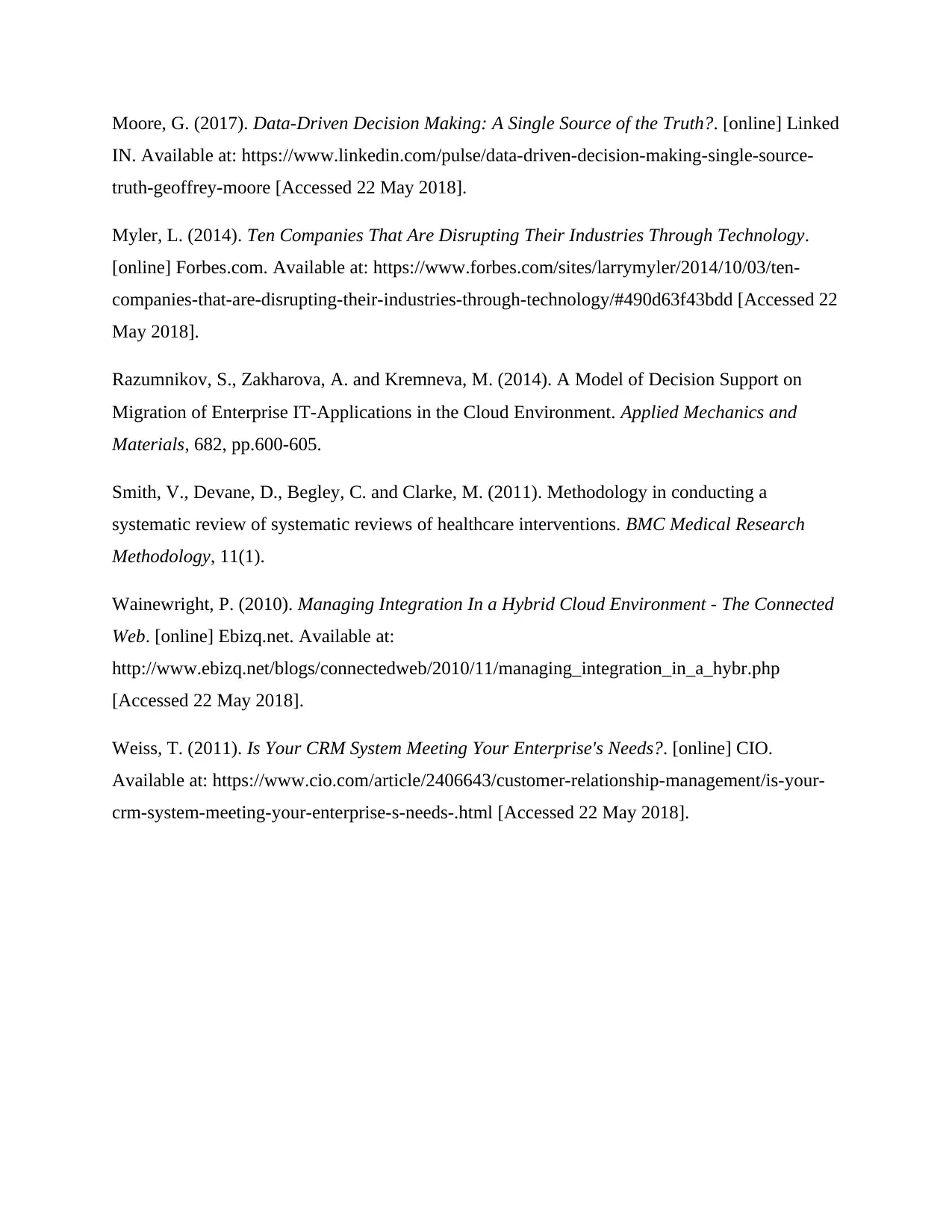
Moore, G. (2017). Data-Driven Decision Making: A Single Source of the Truth?. [online] Linked
IN. Available at: https://www.linkedin.com/pulse/data-driven-decision-making-single-source-
truth-geoffrey-moore [Accessed 22 May 2018].
Myler, L. (2014). Ten Companies That Are Disrupting Their Industries Through Technology.
[online] Forbes.com. Available at: https://www.forbes.com/sites/larrymyler/2014/10/03/ten-
companies-that-are-disrupting-their-industries-through-technology/#490d63f43bdd [Accessed 22
May 2018].
Razumnikov, S., Zakharova, A. and Kremneva, M. (2014). A Model of Decision Support on
Migration of Enterprise IT-Applications in the Cloud Environment. Applied Mechanics and
Materials, 682, pp.600-605.
Smith, V., Devane, D., Begley, C. and Clarke, M. (2011). Methodology in conducting a
systematic review of systematic reviews of healthcare interventions. BMC Medical Research
Methodology, 11(1).
Wainewright, P. (2010). Managing Integration In a Hybrid Cloud Environment - The Connected
Web. [online] Ebizq.net. Available at:
http://www.ebizq.net/blogs/connectedweb/2010/11/managing_integration_in_a_hybr.php
[Accessed 22 May 2018].
Weiss, T. (2011). Is Your CRM System Meeting Your Enterprise's Needs?. [online] CIO.
Available at: https://www.cio.com/article/2406643/customer-relationship-management/is-your-
crm-system-meeting-your-enterprise-s-needs-.html [Accessed 22 May 2018].
IN. Available at: https://www.linkedin.com/pulse/data-driven-decision-making-single-source-
truth-geoffrey-moore [Accessed 22 May 2018].
Myler, L. (2014). Ten Companies That Are Disrupting Their Industries Through Technology.
[online] Forbes.com. Available at: https://www.forbes.com/sites/larrymyler/2014/10/03/ten-
companies-that-are-disrupting-their-industries-through-technology/#490d63f43bdd [Accessed 22
May 2018].
Razumnikov, S., Zakharova, A. and Kremneva, M. (2014). A Model of Decision Support on
Migration of Enterprise IT-Applications in the Cloud Environment. Applied Mechanics and
Materials, 682, pp.600-605.
Smith, V., Devane, D., Begley, C. and Clarke, M. (2011). Methodology in conducting a
systematic review of systematic reviews of healthcare interventions. BMC Medical Research
Methodology, 11(1).
Wainewright, P. (2010). Managing Integration In a Hybrid Cloud Environment - The Connected
Web. [online] Ebizq.net. Available at:
http://www.ebizq.net/blogs/connectedweb/2010/11/managing_integration_in_a_hybr.php
[Accessed 22 May 2018].
Weiss, T. (2011). Is Your CRM System Meeting Your Enterprise's Needs?. [online] CIO.
Available at: https://www.cio.com/article/2406643/customer-relationship-management/is-your-
crm-system-meeting-your-enterprise-s-needs-.html [Accessed 22 May 2018].
⊘ This is a preview!⊘
Do you want full access?
Subscribe today to unlock all pages.

Trusted by 1+ million students worldwide
1 out of 12
Related Documents
Your All-in-One AI-Powered Toolkit for Academic Success.
+13062052269
info@desklib.com
Available 24*7 on WhatsApp / Email
![[object Object]](/_next/static/media/star-bottom.7253800d.svg)
Unlock your academic potential
Copyright © 2020–2025 A2Z Services. All Rights Reserved. Developed and managed by ZUCOL.





